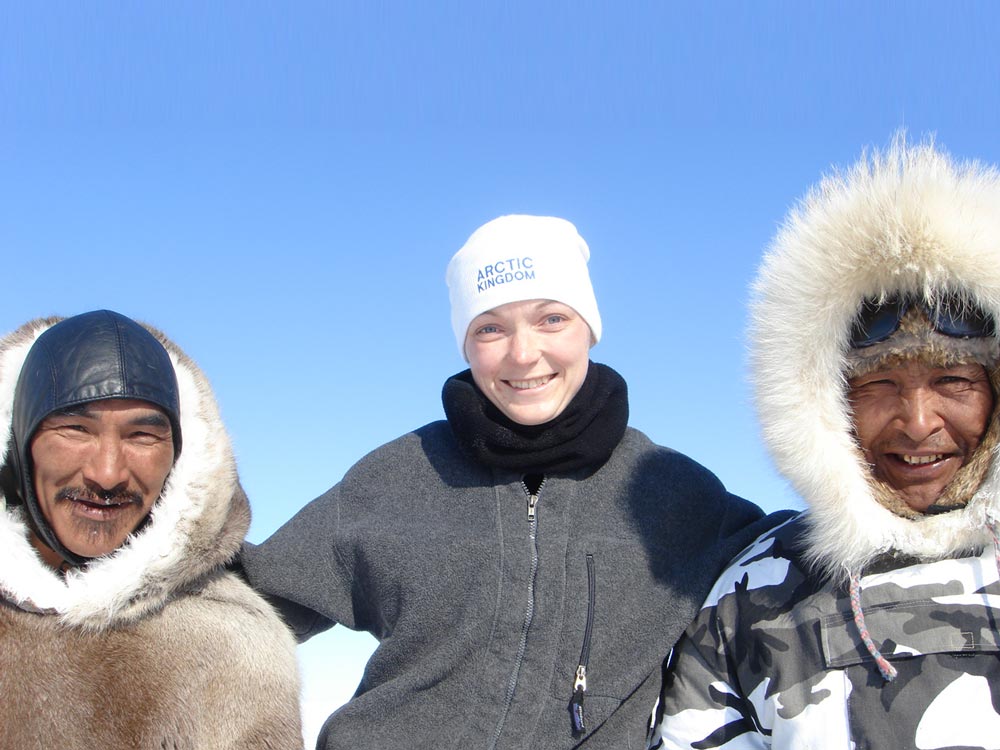The storied community of Gjoa Haven is located on the southeast coast of King William Island at the heart of the Northwest Passage.
The English name for this place honours the Norwegian explorer Roald Amundsen who wintered here with his ship the Gjøa. He called this place ‘the finest little harbour in the world.’ In 1906 he was the first European explorer to transit the Northwest Passage.
The John Ross expedition of 1829-1833 had previously visited this region and the ill-fated John Franklin expedition of 1845 perished nearby, so Gjoa Haven is often visited by arctic history buffs.
1,446
95% Inuit
Inuktitut, English
Longitude 95° 51’ W
Latitude 68° 38’ N
Elevation 47m
Gjoa Haven is situated on the flat coastal terrain of King William Island, consisting of sand, gravel, boulders, sandstone and limestone bedrock. The tundra becomes dappled with wildflowers in the summertime.
Weather & Climate
Summer temperatures are nice and moderate, often rising to 15°C. Winter temperatures are very cold, ranging from -20°C to -40°C before wind chill. The sea ice freezes solid in November and breaks up in July-August.
| Average Temperature in Gjoa Haven | |||
|---|---|---|---|
| January | -34oC | February | -34oC |
| March | -28oC | April | -20oC |
| May | -9oC | June | 1oC |
| July | 8oC | August | 5oC |
| September | 0oC | October | -10oC |
| November | -22oC | December | -30oC |
HISTORY
The native people of Gjoa Haven are Netsilingmiut (‘people of the place where there is seal’). The Netsilik Inuit are direct descendants of the ancient Thule people and they have lived in the area around Gjoa Haven, Taloyoak and Kugaaruk for over a thousand years.
Thule Culture (Proto-Inuit): 1000 AD to 1600 AD
Inuit Culture (Eskimo): 1600 AD to present-day
Netsilik Inuit contact with Europeans began in 1829-1833 when the Scottish explorer John Ross and his crew were trapped in ice near the Boothia Peninsula. They survived with Netsilingmiut assistance. The 1845 John Franklin expedition fared much worse. Franklin and his entire crew died without ever finding the Northwest Passage.
On August 28, 1903 the great Norwegian explorer Roald Amundsen founded the settlement of ‘Gjøahavn.’ He named it this because its harbour protected his ship the Gjøa for two winters when he lived among the Netsilingmiut. His historic discovery and safe 1906 transit of the Northwest Passage in the Gjøa is due in large part to the generous help he got from the local Netsilik Inuit people who clothed him properly and taught him arctic survival techniques of hunting, fishing and tool making.
In 1927, the Hudson Bay Company opened a port and a fur trading post in Gjoa Haven.
The 1961 population of Gjoa Haven was only 110 people, but it has grown steadily with salaried employment opportunities and improved housing, health care and educational facilities. Most Inuit residents still spend a month or two on the land each summer.
ACTIVITIES AND WILDLIFE
Gjoa Haven is an ever-popular destination for fans of arctic history, with excellent cultural venues to visit including the Heritage Centre, the Hamlet Centre and the Northwest Passage Territorial Trail.
In the warm months when the tundra is covered with pretty flowers and the sea is open, boating, hiking, camping, hunting, fishing, berry picking, bird watching and ATV riding are the most popular outdoor activities.
A handsome herd of muskoxen lives on the island and there are some caribou too. There are dozens of lakes that are great spots for char fishing. The sunny days of April and May offer the best conditions for snowmobiling and dog sledding, for exploring the island on skis or for heading out onto the sea ice. In May there is a two-week long celebration in Gjoa Haven called the ‘Qavvavik Frolics’ featuring drum dancing, throat-singing, traditional Inuit games and feasts.
From August to October you can boat to the mainland to visit the Queen Maud Gulf Bird Sanctuary. At any time of the year, you are always warmly welcomed to ‘the finest little harbour in the world.’
ARTS AND CULTURE
Gjoa Haven is known for its vibrant arts and crafts scene, where carvers are famous for their renderings of shamanistic faces and talented seamstresses produce beautiful articles of Inuit clothing.
Parks
Northwest Passage Territorial Trail
The Northwest Passage Territorial Trail is an informative walking tour that describes the quest of dozens of European explorers to find the Northwest Passage and to locate any trace of the lost Franklin expedition. This pleasant stroll back into time follows a path that winds its way in and around the hamlet. The journey begins at the cultural display describing the Netsilik Inuit people located in the Heritage Centre, it leads to more displays about famous arctic explorers at the Hamlet Centre, and it concludes on the hill above the beach at the cairn dedicated to Roald Amundsen, the Norwegian explorer who formed a special relationship with the Netsilik Inuit people of Gjoa Haven.
Queen Maud Migratory Bird Sanctuary
This migratory bird sanctuary is located on the mainland across the Queen Maud Gulf from Gjoa Haven. It is Canada’s largest federally protected nature preserve and it is home to one of the greatest concentrations of nesting geese on Earth. The landscape has countless shallow lakes and huge expanses of arctic lowland.



